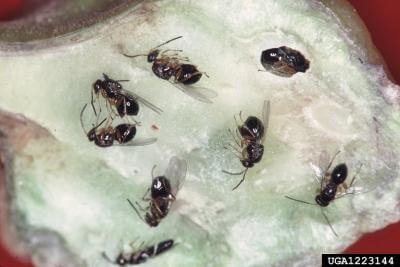
NOTE: this pest is not known to spread in or on firewood. It is included in the Gallery of Pests for general information purposes only.
The American chestnut (Castanea dentata) and the Allegheny and Ozark chinkapins (both Castanea pumila) have been attacked in succession by three different exotic pests: chestnut gall wasp, phytophthora root rot, and chestnut blight.
Efforts to reintroduce American chestnut will probably be hampered by another pest, the chestnut gall wasp, which was first reported in 1974 (Payne et al., 1975). This pest was illegally imported into the country on smuggled budwood and became established in a chestnut orchard in southern Georgia. Chestnut gall wasps lay eggs in bud and flower tissue. Feeding by the larvae results in the tree forming a characteristic gall. Branch die-back can occur, possibly from toxins produced by the larvae, and severe infestations can result in tree mortality. Although there are biological controls for the chestnut gall wasp, none has been evaluated in North America (Murakami et al., 1995; Yara et al., 2000). Chinkapins appear to be resistant or immune to chestnut gall wasp and may be a source of resistance for breeding programs.
USFS scientists and managers developed a conservation priority-setting framework for forest tree species at risk from pest & pathogens and other threats. The Project CAPTURE (Conservation Assessment and Prioritization of Forest Trees Under Risk of Extirpation) uses FIA data and expert opinion to group tree species under threat by non-native pests into vulnerability classes and specify appropriate management and conservation strategies. The scientists prioritized 419 tree species native to the North American continent. The analysis identified 15 taxonomic groups requiring the most immediate conservation intervention because of the tree species’ exposure to an extrinsic threat, their sensitivity to the threat, and their ability to adapt to it. Each of these 15 most vulnerable species, and several additional species, should be the focus of both a comprehensive gene conservation program and a genetic resistance screening and development effort. Chestnut gull wasp is not known to be a threat to any of these 15 most vulnerable species.
Sources
Murakami, Y., N. Ohkubo, S. Moriya, Y. Gyoutoku, C. H. Kim, and J. K. Kim. 1995. Parasitoids of Dryocosmus kuriphilus (Hymenoptera: Cynipidae) in South Korea with particular reference to ecologically different types of Torymus (Syntomaspis) sinensis (Hymenoptera: Torymidae). Appl. Entomol. Zool. 30: 277-284.
Payne, J. A., A. S. Menke, and P. M. Schroeder. 1975. Dryocosmus kuriphilus Yasumatsu, (Hymenoptera: Cynipidae), an oriental chestnut gall wasp in North America. U. S. Dept. Agr. Coop. Econ. Insect Report 25(49-52): 903-905.
Potter, K.M., Escanferla, M.E., Jetton, R.M., Man, G., Crane, B.S., Prioritizing the conservation needs of US tree spp: Evaluating vulnerability to forest insect and disease threats, Global Ecology and Conservation (2019), doi: https://doi.org/10.1016/
Yara, K., E. Yano, T. Sasawaki, and M. Shiga. 2000. Detection of hybrids between introduced Torymus sinensis and native T. beneficus (Hymenoptera: Torymidae) in central Japan, using malic enzyme. Applied Entomol. Zool. 35: 201-206.



